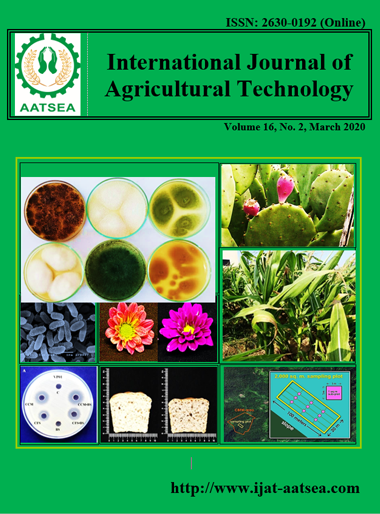Siderophore producing Pseudomonas spp. isolated from rhizospheric soil and enhancing iron content in Arachis hypogaea L. plant
Main Article Content
Abstract
Pseudomonas aeruginosa PSA01 and Pseudomonas fluorescences PSF02 were isolated from rhizospheric of agriculture soil Salem district in Tamil Nadu, India, and confirmed species using biochemical test and molecular phylogeny. Both isolates proved to produce siderophore and solubilized phosphate. Pot experiment resulted to promote the growth of Arachis hypogaea. Inoculated PSA01 and PSF02 significantly increased in the root length, shoot length, fresh weight and dry weight, iron and oil content as compared to untreated control. Total chlorophyll and carotenoids content increased in treated plants. Dual culture technique showed a good biocontrol efficiency of PSF02 activity against Fusarium oxysporum. PGPR culture expressed plant growth potential and inhibited phytopathogen could be exploited as effective bioinoculant for sustainable farming of peanut.
Article Details

This work is licensed under a Creative Commons Attribution-NonCommercial-NoDerivatives 4.0 International License.
References
Ahmad, F., Ahmad, I. and Khan, M. S. (2005). Indole acetic acid production by the indigenous isolates of Azotobacter and fluorescent Pseudomonas in the presence and absence of tryptophan. Turkish Journal of Biology, 29:29-34.
Arnon, O. I. (1949). Copper enzymes in isolated chloroplasts.1. Polyphenol Oxidase in Betavulgaris. Plant, 24:1-15.
Arnow, L. E. (1937). Colorimetric determination of the components of di hydroxphenylanine tyrosine mixtures. Journal of Biological Chemistry, 118:531537.
Bhattacharjee, R. and Dey, U. (2014). Biofertilizer a way towards organic agriculture a review. African journal of microbiology Research, 8:2332-2343.
Eden, P. A., Schmidt, T. M. and Blakemore, R. P. (1991). Pace Phylogenetic analysis of Aquaspirillum magnetotacticum using polymerase chain reaction-amplified 16S rRNA-specific DNA. International journal of systematic and evolutionary microbiology, 4:324-325.
Gupta, A., Gopal, M. and Tilak. K. V. (2000). Mechanism of plant growth promotion by rhizobacteria. Indian Journal of Experimental Biology, 38:856-862.
Harrison, F., Browning, L. E., Vos, M. and Buckling, A. (2006). Cooperation and virulence in acute Pseudomonas aeruginosa infections. BMC Biol0gy, 4:21.
Hu, Q. P. and Xu, J. U. (2011). A simple double layered chrome azurol S agar (SD CASA) plate assay to Optimize the production of siderophores by a potential biocontrol agent Bacillus. African Journal of Microbiology Research, 5:4321-4327.
Krick, J. T. O. and Allen, R. L. (1965). Dependence of chloroplast pigments synthesis on protein synthetic Selenium dioxide were powdered separately and mixed together effects on actilione. Biochemical and BiophysicsResearch Journal of Canada, 27:523-530.
Mehri, I., Khessairi, A., Turki, Y., Saidi, N., Daly, I., Meyer, J. M. and Hassen, A. (2012). Effect of dose-response of zinc and manganese on siderophores production. American Journal of Environmental Science, 8:143-151.
Neilands, J. B. (1974). Iron and its role in microbial physiology. In: Neilands, J.B. editor, Microbial iron Metabolism a comprehensive treative New York: Academic Press, 44:449-467.
Noori, M. S. S. and Saud, H. M. (2012). Potential plant growth promoting Activity of Pseudomonas spp. Isolated from Paddy Soil in Malaysia as Biocontrol Agent. Journal of Plant Pathology & Microbiology, 3:1-4.
Pahari, A., Dangar, T. K. and Mishra, B. B. (2016). Siderophore quantification of bacteria from sundarban and its effect on growth of brinjal (Solanum melongena L.). The Bioscan, 11:2147-2151.
Payne, S. M. (1994). Detection, isolation, and characterization of siderophore methods. Enzymolgy, 235:329-344.
Poland, N. (2007). Total and extractable iron in selected herbs collected from natural areas in. Kerla polonica, 53:27-33.
Reshma, P., Naik, M. K., Aiyaz, M., Niranjana, S. R., Chennappa, G., Shaikh, S. S. and Sayyed, R. Z. (2018) Induced systemic resistance by2,4-diacetylphloroglucinol positive fluorescent Pseudomonas strains against rice sheath blight. Indian Journal of Expremental Biology, 56:207-212.
Saha, M. and Sarkar, S. (2016). Microbial siderophores and their potential applications: a review. Environmental Science and Pollution Research, 23:3984-3999.
Sambrook, J. and Russel, D. (2001). Molecular cloning: A laboratory manual Cold spring harbor laboratory press, cold Spring Harbor, NY, USA.
Sayyed, R. Z., Ilyas, N.,Tabassum, B., Hashem, A., Abd_Allah, E. F. and Jadhav, H. P. (2019). Role of Plant Growth-Promoting Rhizobacteria in Future Climatic Scenario. Environmental Biotechnology: For Sustainable Future, 175-189.
Sayyed, R. Z., Badgujar, M. D., Sonawane, H. M., Mhaske, M. M. and Chincholkar, S. B. (2005). Production of microbial iron chelators (siderophores) by fluorescent pseudomonas. Indian Journal of Biotechnology, 4:484-490.
Schwyn, B. and Neilands, J. B. (1987). Universal chemical assay for the detection and determination of siderophores. Analytical Biochemistry, 160:47-56.
Shaikh, S. S., Patel, P. R., Patel, S. S.,Nikam, S. D., Rane, T. U. and Sayyed, R. Z. (2014). Production of biocontrol traits by banana field fluorescent pseudomonads and their comparison with chemical fungicides. Indian Journal of Experimental Biology, 52:917-920.
Sharma, D., Shankhdhar, S. C. and Shankhdhar. (2013). Enhancing grain iron content of rice by the application of plant growth promoting Rhizobacteria. Plant, Soil and Environment, 59:89-94.
Singh, R., Pandey, D. K. and Kumar, A. (2017). PGPR isolates from the rhizosphere of vegetable crop Momordica charantia: characterization and application as biofertilizer. International Journal of Current Microbiology and Applied Sciences, 6:1789-1802.
Snow, G. A. (1954). Mycobactin: A growth factor for mycobacterium johnei. II. Degradation and identification of fragments. Journal of the American Chemical Society, 2588-2596.
Sridevi, M. and Mallaliah, K. V. (2007). Production of catechol type of siderophore by Rhizobium strains from Sesbania sesban L. Mer. Asian Journal of Biological Sciences, 3:187-194.
Tailor A. J. and Joshi, B. H. (2012). Characterization and optimization of siderophore production from Pseudomonas fluorescens strain isolated from sugarcane rhizosphere. Journal of Environmental Research And Development, 6:688-694.
Tripathi, P., Banerjee, G., Saxena, S., Gupta, S. M. and Ramteke, P. W. (2011). Antibiotic resistance pattern of Pseudomonas aeruginosa isolated from patients of lower respiratory tract infection. African Journal of Microbiology Research, 5:2955-2959.
Wilson, P. W. and Knight, S. C. (1952). Experiments in Bacterial Physiology Burguess, Minneapolis, USA.


